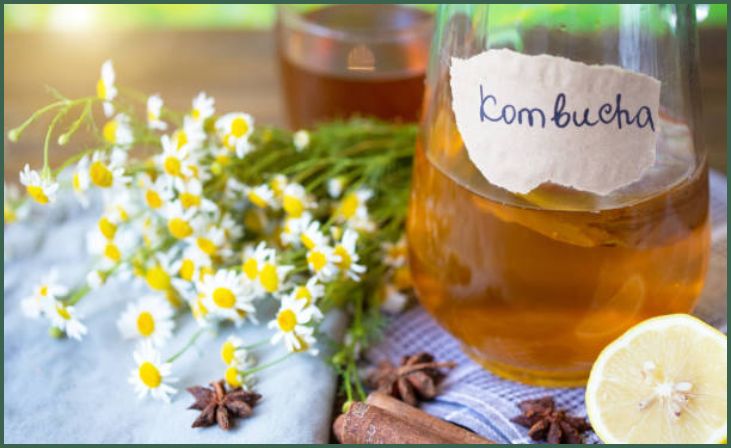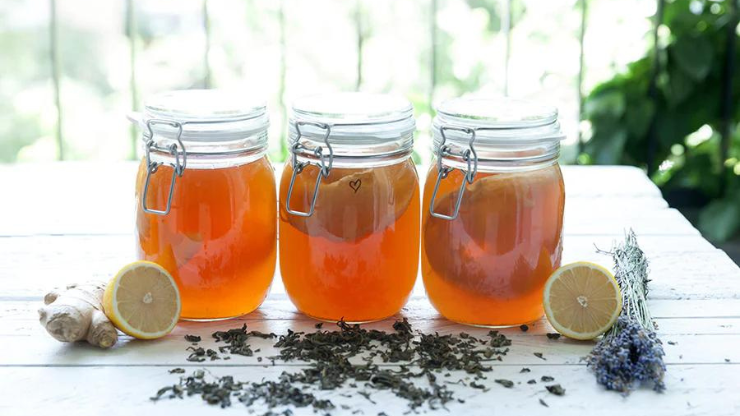Different Kombucha Recipes – Looking to dive into the world of kombucha? Delve into the diverse and delicious realm of 3 different kombucha recipes that are sure to tantalize your taste buds. From the tangy notes of fruit-infused variations to the comforting warmth of herbal blends, these recipes offer a delightful journey into the art of kombucha making. Whether you’re a seasoned kombucha enthusiast or just beginning your fermenting adventure, these recipes are bound to elevate your brewing experience and broaden your palate.
What’s Wrong with Your Kombucha? 5 Things To Know
Before learning about the 3 different Kombucha recipes, you must know 5 important things that destroy the taste of your Kombucha. Here are five common issues that might arise during the kombucha brewing process:
- pH Imbalance: One of the most common issues in kombucha brewing is a fluctuation in pH levels, which can affect the taste and safety of the final product. A highly acidic or overly basic environment can inhibit the growth of beneficial bacteria and yeast, leading to off-flavors or potential contamination.
- Mold Growth: Mold growth on the surface of your kombucha is a clear sign of contamination and can pose health risks if consumed. This issue often arises due to poor hygiene practices, improper temperature control, or exposure to airborne contaminants. Prompt action is crucial to prevent the spread of mold and salvage the batch.
- Slow or No Fermentation: If your kombucha is taking longer than usual to ferment or showing no signs of fermentation, it could be due to various factors such as low room temperature, inadequate yeast or bacteria activity, or improper sugar-to-tea ratio. Understanding the ideal conditions for fermentation and ensuring the presence of healthy cultures is vital to prevent stalling fermentation.
- Unpleasant Odor: A foul or off-putting odor emanating from your kombucha could indicate the growth of harmful bacteria or yeast. Factors such as contaminated equipment, prolonged fermentation, or exposure to unsanitary conditions can contribute to the development of unpleasant odors. Prompt identification and rectification of the root cause are essential to salvage the batch.
- Undesirable Taste: If your kombucha has an excessively sour, bitter, or overly sweet taste, it may be an indication of an imbalance in the fermentation process. Factors such as over-fermentation, inadequate sugar consumption by the cultures, or improper brewing temperature can result in a less-than-desirable taste profile. Monitoring the brewing process closely and adjusting the brewing conditions can help in achieving the desired flavor balance.
Understanding and addressing these common issues during the kombucha brewing process can help maintain the quality and safety of your homebrewed kombucha. Regular monitoring, adherence to hygiene practices, and adjustments to the brewing environment are key to producing a successful batch of flavorful and healthy kombucha.
Also Read: Traditional Herbal Root Beer
Different Kombucha Recipes With Ingredients & Instructions
Here you will learn about the 3 different Kombucha recipes to make your Kombucha delicious.
Fizzy Kombucha

To make fizzy kombucha, you will need the following ingredients and instructions:
Ingredients:
- 1 gallon of filtered water
- 8 bags of black or green tea (or 2 tablespoons of loose-leaf tea)
- 1 cup of granulated sugar
- 1 cup of matured kombucha from a previous batch (or store-bought kombucha)
- 1 SCOBY (a growth of bacteria and yeast that works well together)
Instructions:
- Boil the filtered water and remove it from the heat source. Add the tea bags or loose-leaf tea and allow it to steep for 15 minutes.
- Remove the tea bags or strain out the loose leaves, and then stir in the granulated sugar until it dissolves completely. Let the sweetened tea solution cool to room temperature.
- Transfer the cooled tea into a sterilized, glass gallon jar, leaving some space at the top. Pour in the matured kombucha from a previous batch or store-bought kombucha.
- With care, put the SCOBY on top of the liquid. Cover the jar with a tightly woven cloth or paper towel and secure it with a rubber band to prevent contamination while allowing air circulation.
- Store the jar in a warm, well-ventilated area, away from direct sunlight. Let the kombucha ferment for 7 to 14 days, depending on the desired level of tartness and fizziness. Monitor the fermentation process by tasting the kombucha every few days.
- After the initial fermentation period, carefully remove the SCOBY and 1-2 cups of the matured kombucha for the next batch.
- For carbonation, transfer the remaining kombucha into airtight bottles. Optionally, add flavorings like fruit juice, ginger, or herbs at this stage.
- Seal the bottles tightly and allow them to carbonate for 1 to 3 days at room temperature. Check the carbonation level by gently opening the bottle. If it produces a satisfying fizzing sound, it’s ready to be refrigerated to slow down further fermentation.
- Refrigerate the fizzy kombucha before serving to chill it and enjoy it at its best. Remember to release any excess pressure from the bottles occasionally to prevent explosions.
With these simple steps, you can create your own batch of fizzy kombucha, full of probiotic goodness and effervescent flavor.
Don't just scroll, subscribe!
BuzzTrail's unique web-stories are the cure for boredom you've been waiting for.
Pumpkin Spice Kombucha

To make Pumpkin Spice Kombucha, you’ll need the following ingredients and instructions:
Ingredients:
- 1 gallon of filtered water
- Eight bags of black tea, or two tablespoons of dried black tea
- 1 cup of granulated sugar
- 1 cup of matured kombucha from a previous batch (or store-bought kombucha)
- 1 SCOBY (a growth of bacteria and yeast that works well together)
- 1 cup of pumpkin puree
- 1 teaspoon of pumpkin pie spice blend
- Additional sugar or sweetener (optional, to taste)
Instructions:
- Boil the filtered water and remove it from the heat source. Add the black tea bags or loose-leaf black tea and let it steep for 15 minutes.
- Remove the tea bags or strain out the loose leaves and stir in the granulated sugar until it fully dissolves. Let the sweetened tea solution cool to room temperature.
- In a separate bowl, combine the pumpkin puree and pumpkin pie spice blend until thoroughly mixed.
- Add the pumpkin mixture to the cooled sweetened tea, stirring gently to ensure even distribution.
- Transfer the mixture to a sterilized, glass gallon jar. Pour in the matured kombucha from a previous batch or store-bought kombucha.
- With care, put the SCOBY on top of the liquid. Cover the jar with a tightly woven cloth or paper towel, securing it with a rubber band to prevent contamination while allowing air circulation.
- Keep the jar somewhere warm and airy that isn’t in full sunlight. Let the kombucha ferment for 7 to 14 days, depending on the desired level of tartness and flavor.
- After the initial fermentation period, carefully remove the SCOBY and 1-2 cups of the matured kombucha for the next batch.
- Taste the pumpkin spice kombucha, and if desired, add additional sugar or sweetener to adjust the sweetness level.
- Bottle the kombucha in airtight containers, leaving some room at the top. Seal the containers tightly and allow them to carbonate for 1 to 3 days at room temperature.
- After achieving the desired level of carbonation, refrigerate the pumpkin spice kombucha to chill it before serving. Enjoy the delightful blend of pumpkin and spice notes in your homemade kombucha!
Also Read: How To Make Kvass
Lemon Thyme Green Tea Kombucha

To make Lemon Thyme Green Tea Kombucha, you’ll need the following ingredients and instructions:
Ingredients:
- 1 gallon of filtered water
- 8 bags of green tea (or 2 tablespoons of loose-leaf green tea)
- 1 cup of granulated sugar
- 1 cup of matured kombucha from a previous batch (or store-bought kombucha)
- 1 SCOBY (a growth of bacteria and yeast that works well together)
- 1-2 lemons, thinly sliced
- Fresh thyme sprigs
- Additional sugar or sweetener (optional, to taste)
Instructions:
- Boil the filtered water and remove it from the heat source. Add the green tea bags or loose-leaf green tea and let it steep for 10-15 minutes.
- Remove the tea bags or strain out the loose leaves and stir in the granulated sugar until fully dissolved. Let the sweetened tea solution cool to room temperature.
- In a sterilized, glass gallon jar, combine the cooled sweetened tea with the matured kombucha from a previous batch or store-bought kombucha.
- With care, put the SCOBY on top of the liquid. Add the thinly sliced lemons and fresh thyme sprigs to the jar.
- Cover the jar with a tightly woven cloth or paper towel, securing it with a rubber band to prevent contamination while allowing air circulation.
- Keep the jar somewhere warm and airy that isn’t in full sunlight. Let the kombucha ferment for 7 to 14 days, depending on the desired level of tartness and flavor.
- After the initial fermentation period, carefully remove the SCOBY and 1-2 cups of the matured kombucha for the next batch.
- Taste the lemon thyme green tea kombucha, and if desired, add additional sugar or sweetener to adjust the sweetness level.
- Bottle the kombucha in airtight containers, leaving some room at the top. Seal the containers tightly and allow them to carbonate for 1 to 3 days at room temperature.
- Once the kombucha has reached the desired level of carbonation, refrigerate it to chill before serving. Enjoy the refreshing blend of citrusy lemon and aromatic thyme in your homemade green tea kombucha!
Also Read: How to Make Kombucha
Conclusion
Embrace the art of kombucha crafting with these 3 different kombucha recipes that exemplify the fusion of taste and health. From the zesty punch of citrus to the soothing essence of lavender, each recipe offers a unique journey into the world of probiotic-rich beverages.
Unleash your creativity and palate as you explore the endless possibilities of kombucha, and savor the joy of concocting these delicious, health-boosting elixirs in the comfort of your own home. With these recipes as your guide, embark on a fulfilling and flavorful adventure that promises to invigorate both your taste buds and well-being.
FAQs
What are the benefits of incorporating different kombucha recipes into my routine?
What are the benefits of incorporating different kombucha recipes into my routine?
Incorporating various kombucha recipes into your routine can introduce a range of flavors and potential health benefits. Different ingredients offer unique nutrients, such as vitamins and antioxidants, contributing to overall well-being. Additionally, alternating recipes can prevent flavor fatigue and maintain enthusiasm for your kombucha brewing journey.
Can I change the recipes to fit my food needs or preferences?
Can I change the recipes to fit my food needs or preferences?
Absolutely! Kombucha recipes can be easily customized to cater to specific dietary preferences or restrictions. Whether you follow a vegan, gluten-free, or sugar-free diet, there are ample alternatives and substitutions available. Experiment with various sweeteners, fruit options, and herbal blends to craft kombucha recipes that align with your dietary needs and preferences.

